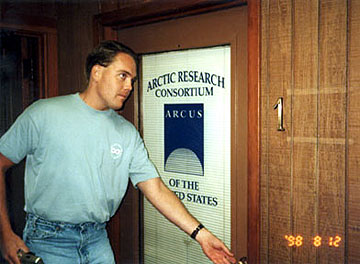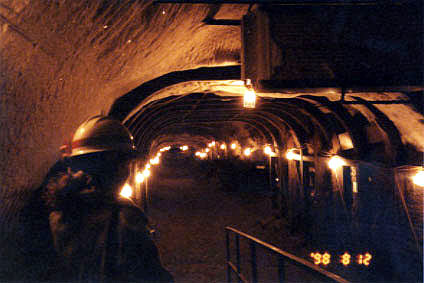11 August, 1998
August 11, 1998
Alaska State Museum****Large Animal Research Station****CRREL Permafrost
Tunnel****The Pipeline****Last minute preparations for the Tundra
The Alaska State museum gave a great history of Native Alaskan people as
well as the economic development of the state. In addition there was a
stuffed grizzly that I got to get my picture with and a big (it seemed to
me) polar bear that was shot off Point Barrow back in the 70's I think. I
really want to see one of those bears in the wild, but I don't at the same
time. They are very aggressive from what I've been told. Playing dead
doesn't work with them.
After the museum we went to see the Large Animal Research Station (LARS) in
Fairbanks to see Muskoxen, Reindeer, and Caribou. The muskoxen are short
squat almost bison-looking animals that have horns on their head that look
like they are flowing out of the top. They are actually more closely
related to sheep and were almost made extinct earlier this century. They
were saved, however, by the efforts of some very forward looking
individuals. Also at the site were reindeer and caribou. I didn't realize
that a reindeer is actually a domesticated caribou (this happened about
2000 years ago). They are a little shorter and fatter than caribou but
they are still the same species. Anna tells us we are guaranteed to see
some wild caribou on the Tundra.
After the LARS we met up with Renee Crain of the Arctic Research Consortium
of the United States (ARCUS) and thus gave Anna a relief from the hard
time that Javier and I had been giving her. We had the honor of going to
see the US Army Corp of Engineers Permafrost Tunnel. Permafrost is defined
as ground that is perennially frozen for at least 2 years straight. Let me
tell you whatŠ.this tunnel went back through 30,000 years at its deepest
point. We got to see ice wedges which are huge ice formations that are
formed from continuous freezing of water in a crack that is thickened every
year by annual freezing and thawing. Kind of like a pot hole in Spokane
that doesn't get fixed. It keeps getting bigger and bigger over the
relatively mild winters we get. We got to see the underside of a polygon,
which will be explained more when I get up to the field sites around
Prudhoe Bay. The tunnel sides were actually soft and not hard as ice as I
had imagined. Apparently it is because of all the organic matter and the
size of the parcticles of loess that is frozen in with the water and gravel
that gives it this texture. After about 30 minutes in the tunnel (which
was -5šC) we were cold enough to come out to warm up
On the way home from the tunnel Javier and I got our first view of the
Trans-Alaska Pipeline. WOW, I mean WOW! This thing is absolutely amazing
from an engineering point of view. A four foot diameter pipe that runs
about 800 miles, above and below, ground and carries 1.2 million barrels
of oil per day to Valdez, Alaska. A barrel is 42 gallons, so I'll let you
all do the math, but it's a whole bunch of money flowing from there to here
everyday!
We leave tomorrow at 8 for the Tundra so I'll go for now. We are all
getting really excited for the experience that we finally get to have. I
CAN HARDLY WAIT! I wish you could be here!
JAVIER'S PIECE
This morning, Don got his dose of his two food groups: caffeine and sugar
(coke). As we got into the car, I turned on the radio and it suddenly went
off about 5 minutes into driving. After fiddling with this thing using the
Don method (extreme external stimulus concentrated in crucial areas:
hitting) I decided to test a tape out in the deck to determine if it was
only the radio that would not function. The tape played fine for about 2
minutes. I gave the suggestion that the tape player/radio would only
function during even times of the dayŠ it was the only thing I could think
of. Don suggested that there could be some thermal anomalies causing the
radio to not work, but I told him that temperature anomalies were only
affecting his reasoning, not the radio. We decided not to worry about it:
if it played, it played.
After this we went to the University museum. I learned a lot about the
historical aspects of Alaska that I was completely ignorant to before I
came here; such as the actual World War II confrontations at the Aleutians
against Japanese forces.
We then visited a research site just out of Fairbanks. They had many
muskoxen, reindeer, and caribou. The horns on the caribou and reindeer are
shed every year whereas the horns of the oxen are never shed. Oxen do shed
both of their coats; one is a thicker outer layer that is coarse, the other
is quiviut (ki-vee-ut), a smooth layer that insulates underneath. This
layer goes for a handsome price, and part of the funding for LARS comes
from the sale of this material.
After LARS, we picked up the wonderfully exuberant Renee Crain. We picked
up the keys to the permafrost tunnel and went there. The tunnel was cold..
very cold. I had to borrow some of the gear that Renee took with her just
to stay warm. Inside the tunnel, there was a thin layer of dirt on the
ground and through that, you could sometimes see the frozen permafrost
beneath us. Walking through the loose dirt in there was like walking on
the moon. It was really a great experience and I got some rocks as
memorabilia.
After leaving the tunnel, Renee posed her own theory for the mysterious
radio glitches: as soon as Anna would park, the radio would turn back on.
We tested this many times and it sure enough worked, just showing the
mental brilliantness of Renee
Now, all we have to work at is finding out how to fix it. Renee is
thinking about it..

Don was eager to open the door to his Arctic Adventure.

Anna entering the CRREL permafrost tunnel.
Contact the TEA in the field at
.
If you cannot connect through your browser, copy the
TEA's e-mail address in the "To:" line of
your favorite e-mail package.
|
